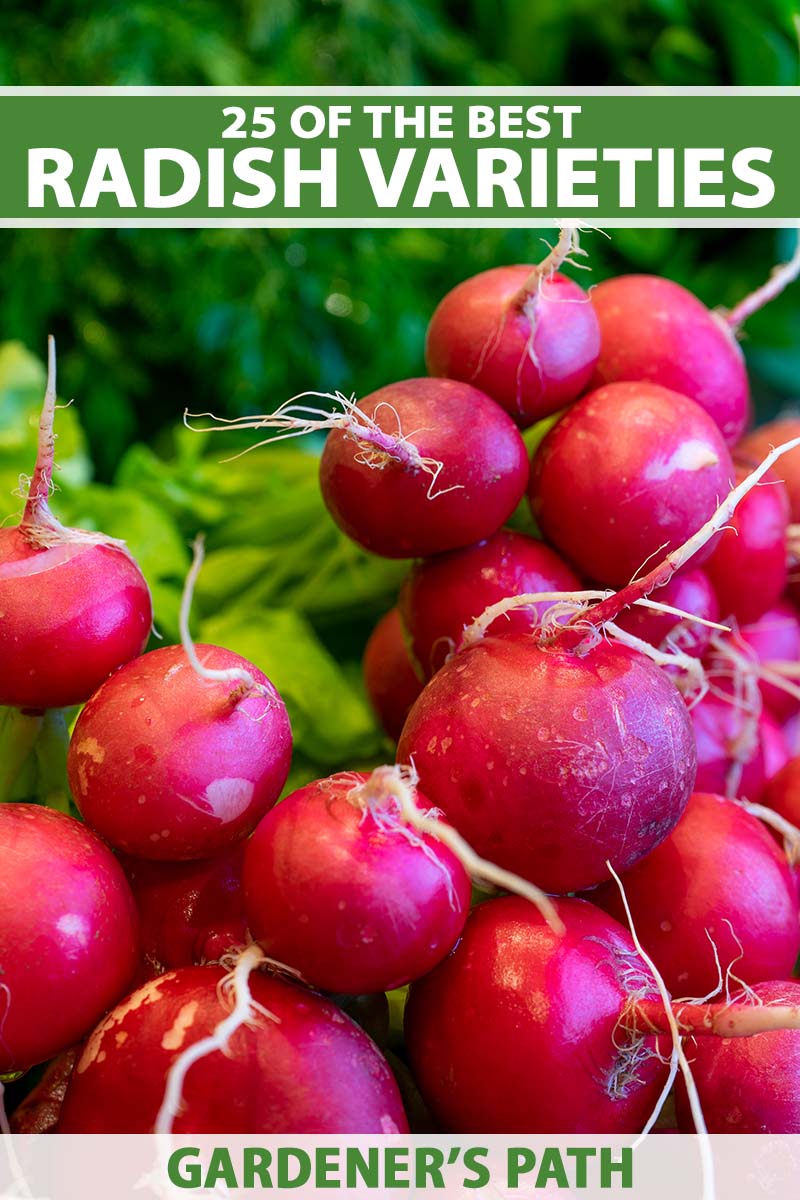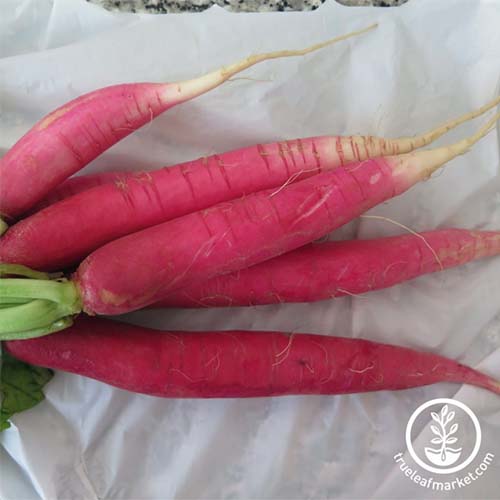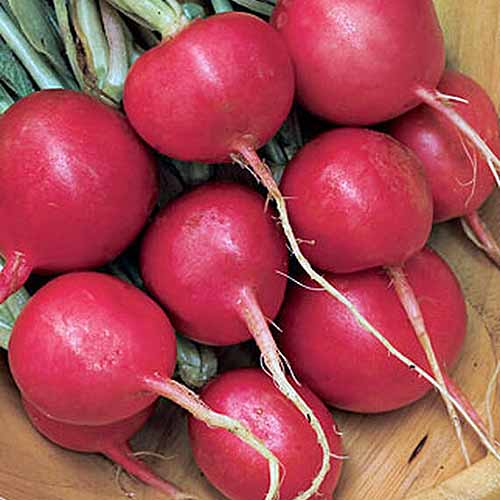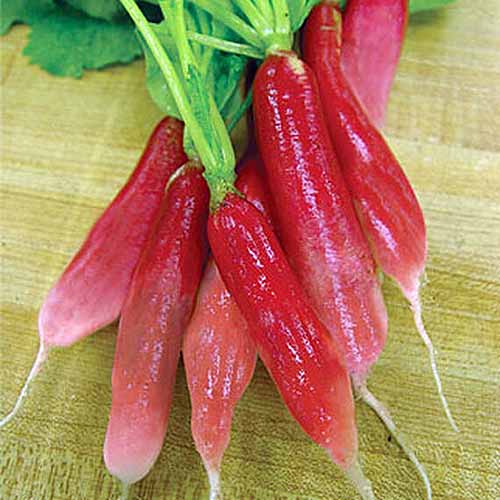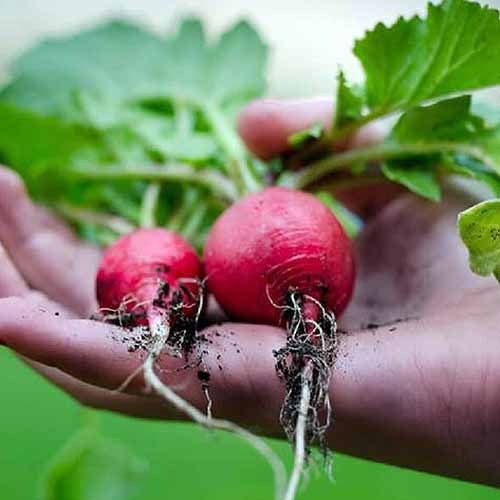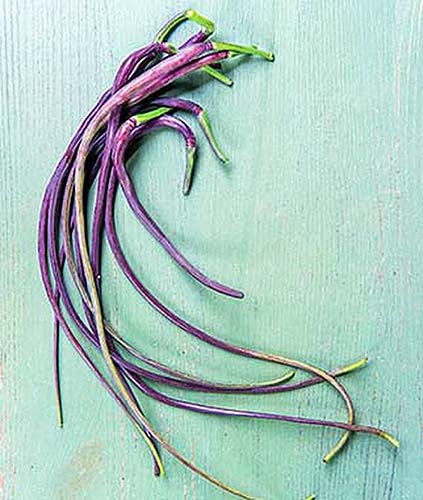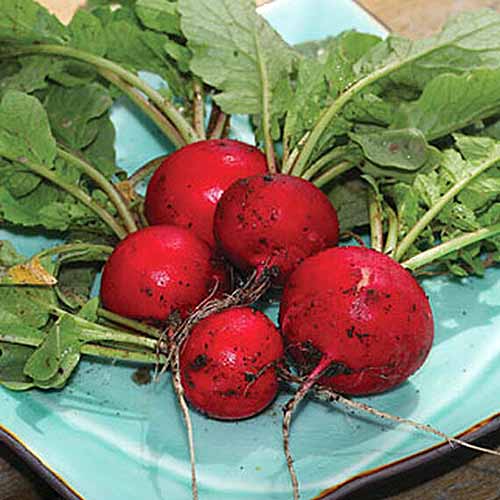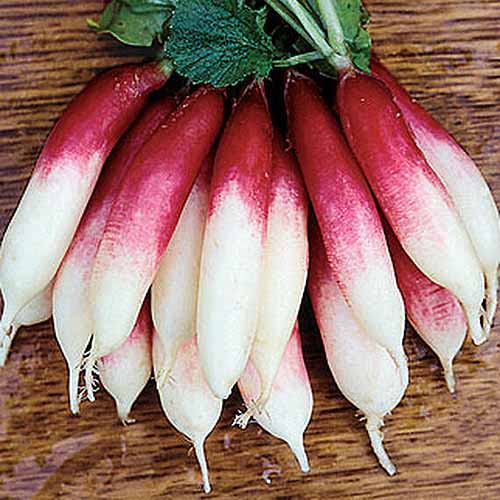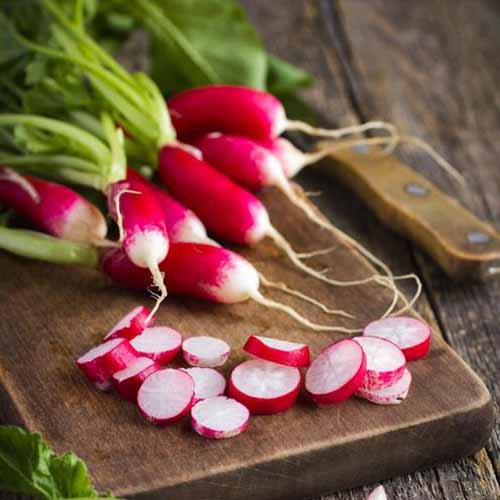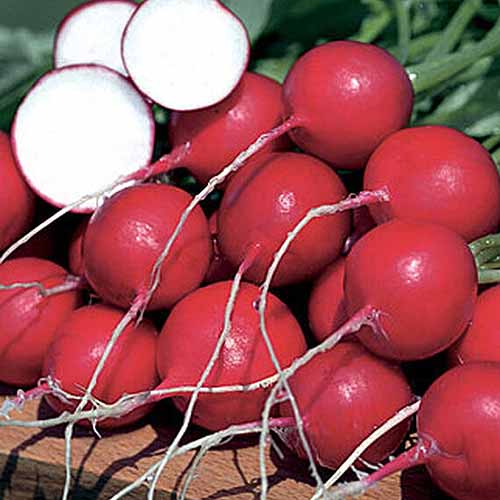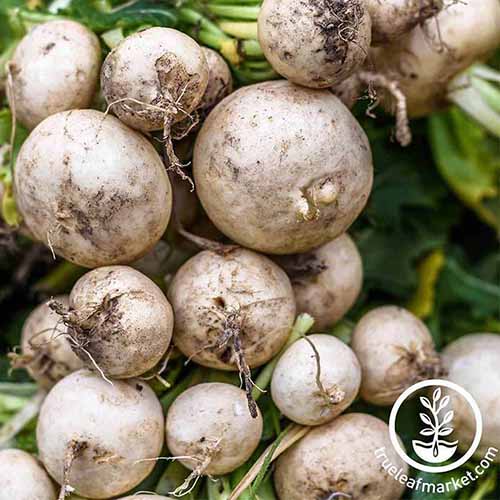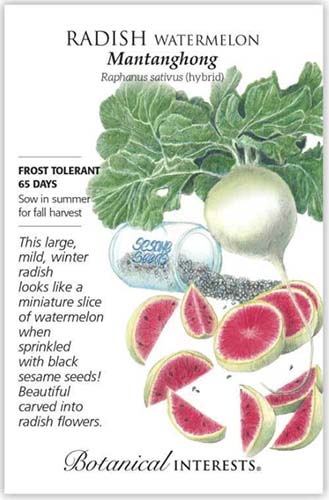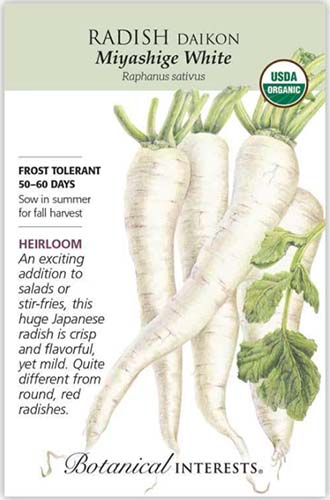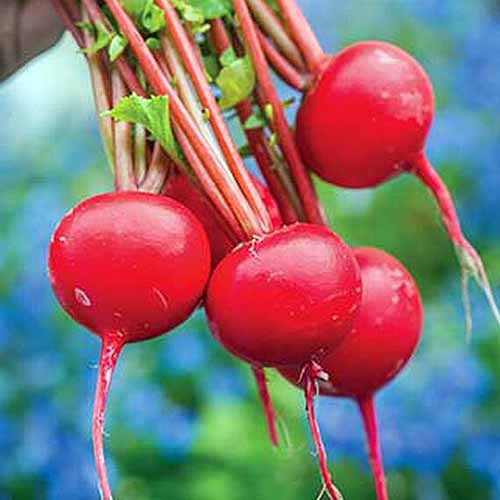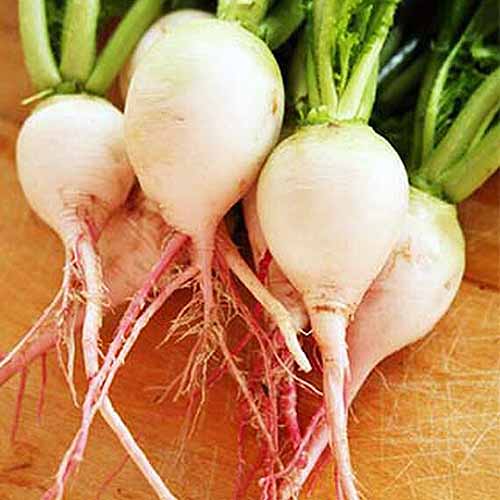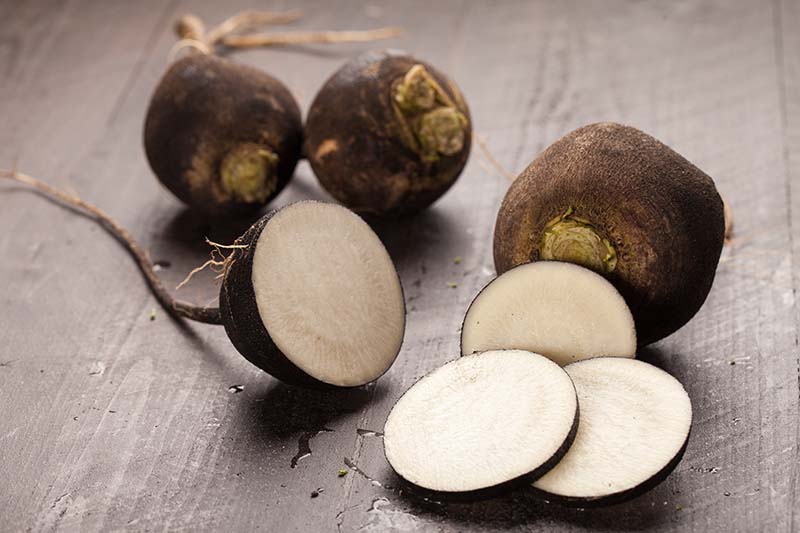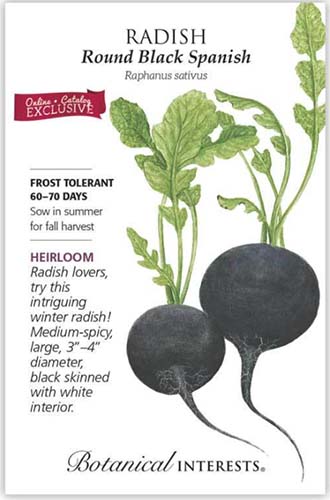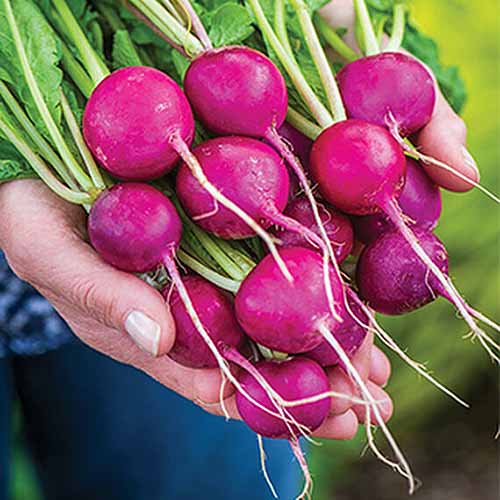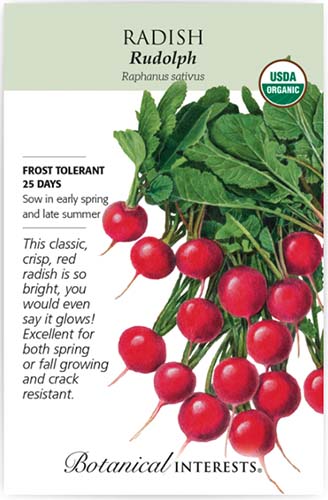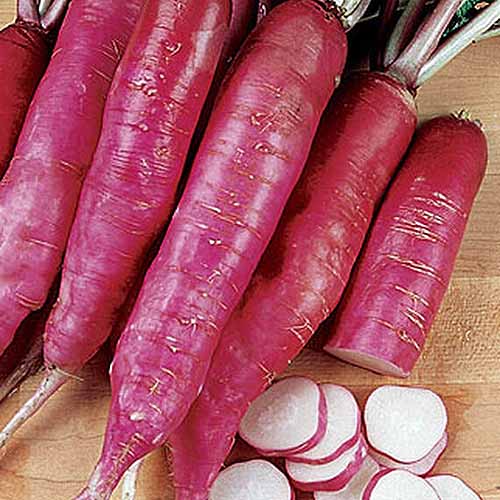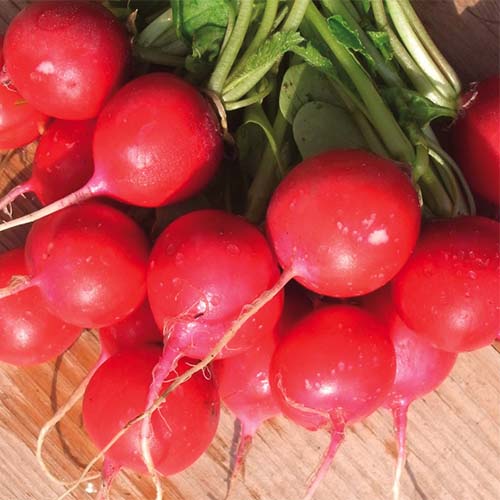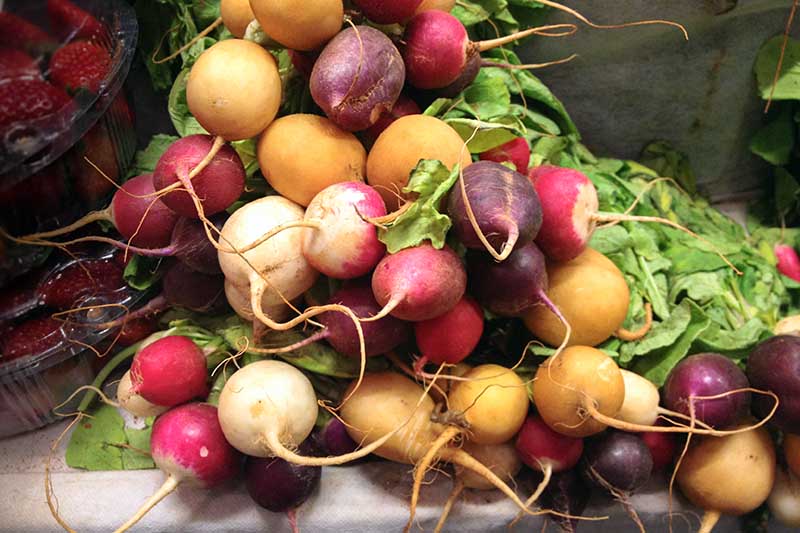But the best radish variety to enjoy for that spring ritual? You’ll get no argument from me there. Nor will I quibble if you prefer a type known as a “winter” radish. They’re planted in the late summer, mature in fall, and can be stored for months in the winter, hence the name. Spring or winter, I’m the first to say there are literally dozens of wonderful varieties of Raphanus sativus available for the home gardener. We link to vendors to help you find relevant products. If you buy from one of our links, we may earn a commission. Or maybe, like me, you’ll love one type best because someone you love once grew it. I’ll share a little more of that story in a bit, but first I want to get right to introducing 25 of the best radish varieties to grow in your garden. Here are the excellent options I’ll share: But while ‘Bartender Mammoth’ can reach nine inches long and they are carrot shaped, they’re brassicas, not umbellifers. These heirloom radishes are crisper and less dense than carrots, with a flavor that’s a bit spicier – though they do have a sweet finish. They’re a convenient length for dipping into tzatziki, hummus, or veggie dip for a healthy appetizer or snack. ‘Bartender Mammoth’ And you can take that name seriously. A lengthwise slice makes an appealing garnish or stirrer for Bloody Marys, or a tasty bar snack alongside IPAs or mojitos. In the garden, ‘Bartender Mammoth’ offers the advantage of a bit of extra tolerance for warm weather, unlike most larger radishes. I still wouldn’t plan to harvest it any later than early summer, though. It’s ready to harvest 35 to 40 days from sowing. You can find ‘Bartender Mammoth’ seeds in bulk and various packet sizes available at True Leaf Market.
2. Cherry Belle
Traditionalists take one look at ‘Cherry Belle’ and say, “Now that’s a radish!” These heirlooms are round, bright red, and an inch across at the optimal harvest time. A great choice for beginners, and impatient cooks and gardeners, ‘Cherry Belle’ produces just 22 days from sowing. ‘Cherry Belle’ Be sure to keep them evenly watered while you’re waiting – that’s the best way to assure crisp, mildly sweet produce for salads, snacking, and the relish tray. ‘Cherry Belle’ seeds in various package sizes as well as seed tape are available from Burpee.
3. China Rose
Pretty in pink! Who knew that compliment could apply to radishes, not just characters in a John Hughes film? This peppery winter cultivar hails from China. It grows straight down six to eight inches, with a diameter of about two inches. ‘China Rose’ A daikon variety, it takes 55 days to mature. Just one is big enough to add zip to an entire family-size salad. And if you don’t use thin slices of ‘China Rose’ to pep up your tacos or top avocado toast, you’ll be missing out! ‘China Rose’ is available in 300-seed packets from Burpee.
4. Crimson Giant
Sometimes a behemoth is just two inches wide and an inch or two long. ‘Crimson Giant’ is only considered large among the globe and icicle radishes. Daikon and red meat radishes are huge in comparison, growing to a foot or more and sometimes weighing several pounds. But this radish has the advantage of growing relatively big in a short time, fewer than 30 days. Unless summer strikes early in your area, you’ll probably have time for two successive crops in the spring and another in early fall. ‘Crimson Giant’ The plump orbs are crispy sliced into salads or minced into gazpacho. They are good for roasting or quick pickles, too, though they’ll lose that appealing pink shade when cooked. These big beauties are ideal for that niche in the vegetable garden that just gets part sun, too. And they’re over and out in time to use the same space later for a warm weather vegetable, like squash or tomatoes. Find ‘Crimson Giant’ seeds in various packet sizes or in bulk available at Eden Brothers.
5. Dragon’s Tail
If you love to experiment in both the kitchen and garden, this radish variety has your name on it. It’s definitely different. An Asian heirloom, ‘Dragon’s Tail’ is an aerial radish. That means you’ll eat its seed pods, not its roots. Honestly, even if the pods weren’t crunchy, light, and spicy, you might want to grow this variety just to look at it, as an ornamental. The plants reach three to four feet tall. They’re lacy and leafy, and bloom in a profusion of delicate pink and white blossoms. ‘Dragon’s Tail’ Those are followed by the edible purple pods, which are best picked when they are three to six inches long, and while they’re still pencil thin. Any longer or plumper and the texture gets tough and the flavor overly hot. You can pluck them and put them right into a salad, or cook them in stir fry. They have a kale or bok choy crispness, with a spicy kick. Raw, ‘Dragon’s Tail’ pods pair wonderfully with creamy dressings. Cooked, they’re a perfect foil to teriyaki or other slightly sweet stir-fry sauces. The pods do take a bit longer to mature than your average spring radish – about 50 days from sowing. You can find ‘Dragon’s Tail’ in 50-seed packets available from Burpee.
6. Early Scarlet Globe
Frankly, my dear, if a director was casting the quintessential radish, this variety would probably get the part. It’s that round, red version we know so well. While it’s typical, it’s also crispy and mild. So it doesn’t get by on looks alone! ‘Early Scarlet Globe’ These are some of the earliest, too, maturing in 20 to 28 days after sowing. ‘Early Scarlet Globe’ is available in 300-seed packets from Burpee.
7. Fire ‘N’ Ice
This Burpee exclusive is a ‘French Breakfast’ lookalike, a hybrid derived from this cultivar that’s about three inches long at its peak, in a magenta shade with a white tip. ‘Fire ‘N’ Ice’ It has a mild taste that isn’t fiery, and is marketed as a microgreen or source of baby greens as well as a full-size spring radish. Find ‘Fire ‘N’ Ice’ in 300-seed packets available at Burpee.
8. French Breakfast
This is the heirloom variety from the late 1800s I am most nostalgic about! It’s mature at two inches long, and about three-quarters of an inch wide. Just the sight of its blocky, elongated red roots with white tips makes me smile. It calls to mind my husband’s Appalachian grandfather, who grew them. I was a youthful, overconfident foodie and he was a retired chemical plant worker making his home in small-town Saltville, Virginia when this topic came up. I was raving about this unusually mild radish I really liked. When I finally came up for air, he told me with a kind chuckle he’d been growing that very variety to eat with bread and butter for a long, long time. His house was on a hill, with a rich loam garden patch at the top. The meals there were tasty, and homey, served with pickles and a dish of sliced tomatoes as likely as not. And they ate radishes French-style in big Carl Slate’s kitchen. This was decades before avocado toast was all the rage at American hipster cafes. The basic technique involves slicing the mild beauties thin on a diagonal, and carefully arranging them atop slices of bread and butter, with a bit of salt on top. Toasting the bread is optional, as is skipping the bread altogether! Nowadays, people tend to refer to all cylindrical red radishes with white tips as “French breakfast,” but this type was introduced as a specific cultivar in France in 1879. Old lore has it that the sellers would eat them with butter and salt to tide them over on busy market days. ‘French Breakfast’ I still grow at least a few of these every year, from the old-school seeds, in honor of Carl Slate, and to eat out of hand. They take about 28 days to be ready for harvest, so they’re not one of the earliest varieties. But I find they are definitely one of the best-tasting and most memorable. Find ‘French Breakfast’ seeds in a variety of packet sizes available at Eden Brothers.
9. French Dressing
Viva la French radish! This hybrid grows a little faster than the traditional ‘French Breakfast’ variety, taking just 21 days to reach maturity. ‘French Dressing’ The mild, crisp flesh is tasty atop toast, a bagel with cream cheese, or a salad. But if you have a way to rinse them on the spot, they’re good nibbled straight from the garden, too. Find ‘French Dressing’ in 600-seed packets available at Burpee.
10. German Giant
Usually if radishes get this large, you have an “uh oh” situation. If you harvest them too late, the flesh becomes stringy, and the flavor is bitter hot. This huge hybrid was bred to stay sweet and crisp at a larger size. It grows to a tasty one and a half inches wide in about 30 days. But you can let ‘German Giant’ grow as large as a baseball without losing texture or altering its mild flavor. Big or really big, these radishes are tasty sliced thin for topping tacos or sandwiches. Or, cut them into “chips” to dip into a favorite hummus or tzatziki. ‘German Giant’ They grow larger-than-average leaves, too. Harvest them young for a salad green or turnip green substitute. Just don’t let them get more than a few inches tall before picking, or the greens become spiny and hot to cook with. Find ‘German Giant’ in 1,000-seed packets available from Burpee.
11. Golden Helios
Probably because they’re named after the Greek sun god, ‘Golden Helios’ remind me of small versions of the golden apples Hercules sought in mythology. They’re a lot easier to acquire, though! They mature just 25 days after sowing. And while that’s not long to wait, you might want to pluck a few leaves before the golden orbs form beneath the soil line. The leaves are a pretty purple-streaked green, and look great in salads or stir-fries. If you’re gardening in an area where there’s occasionally a hot spell in early spring, ‘Golden Helios’ is a good choice. This cultivar can tolerate a bit more warm weather than other spring-planted varieties. ‘Golden Helios’ While the roots are at their juicy, crisp best if harvested at one and a half inches across, you can let them get a bit bigger without also becoming bitter. You have an extra couple of weeks to pull mature ‘Golden Helios,’ but don’t push it if you want top quality harvests.
12. Green Luobo Improved
An Asian radish you’d plant in late summer, harvest in fall, and store for up to eight weeks in the winter, ‘Green Luobo Improved’ is a good choice if you’re growing the ingredients for kimchi. It imparts a light green color to the traditional fermented Korean side dish. You can also nibble on the fresh roots, in salads, sushi, or with dip. This type produces abundantly, with light green roots that are five to seven inches long. ‘Green Luobo Improved’ The improved cultivar is known for an 80 percent germination rate, uniform fruits, and maturing relatively quickly – 57-60 days from sowing to harvest. Unlike many radish varieties, ‘Green Luobo Improved’ leaves don’t have spines. You’ll appreciate the itch- and scratch-free process when you pick or pull.
13. Hailstone
‘Hailstone’ roots resemble baby turnips. You certainly can roast them, or cook the baby greens just as you would their lookalike counterparts. But these pale, round brassicas are particularly mild and juicy when enjoyed raw, and the flesh is firm and crunchy. They mature zip quick, in 25 days, but still produce two-inch orbs. The pale white skin makes them a natural in marinated salads and gazpacho, because they won’t suffuse the dressing or surrounding veggies with pink. ‘Hailstone’ Grow them in succession in early spring, and plant again in late summer for an early fall harvest. Just don’t expect a vegetable named ‘Hailstone’ to thrive in summer heat. They won’t melt when high temperatures hit, but the roots will become hollow, pithy, and bitter – suitable only for the compost. ‘Hailstone’ seeds are available in a variety of packet sizes from True Leaf Market.
14. Mantanghong
This is one of a few fall-harvested varieties described as “watermelon” or “red meat,” and all of them are stunners. The outsides are white with green shoulders, and the interiors are a bright, cheery, dark pink. ‘Mantanghong’ is a hybrid cultivar, improved to deliver more consistently high-quality roots in comparison to older strains. The roots are at least three inches in diameter at maturity, and can weigh as much as a pound! They take 65 days to mature from sowing. The seeds will germinate until temps plummet below 40°F, so this is a great option to extend the season in fall. Plant them eight to 10 weeks before your average first frost. They’ll tolerate some frost, too, but they grow a little slower in the cold, so be sure to account for that. ‘Mantanghong’ Keep in mind, you can’t plant these in the spring! This variety needs short days to trigger the roots to form. And even if you get the plants going in the cool spring temps, they’ll bolt at the first hint of warmer weather. ‘Mantanghong’ seeds are available in one-gram packets from Botanical Interests.
15. Miyashige
Whether you make your own sushi or just want a crispy daikon to add crunch to stir fry, homemade pickles, or tacos, ‘Miyashige’ is a must. A fall-planted heirloom variety, it takes 50 to 60 days to mature. Be prepared for an impressive harvest if you plant ‘Miyashige’ in your garden. This white daikon grows 12 to 18 inches long and two to three inches in diameter. ‘Miyashige’ You can grow it in containers or raised beds, too, but make sure they’re deep enough! Find ‘Miyashige’ white daikon seeds in two-gram packets available at Botanical Interests.
16. Perfecto
If you tend to take late spring vacations or are a little haphazard in your harvest habits, this is one of the few forgiving globe radishes. It keeps its shape even if you let it grow a bit past its prime. Wouldn’t it be fun if we could all do that? Ideally, you’ll harvest these at one inch in diameter, the size they attain about 25 days from sowing. That’s when they’re at their juiciest. But they will stay crisp and grow larger while maintaining the same shape if you leave them in the ground a little longer. Even baseball sized, they’re still tasty. ‘Perfecto’ When the greens have grown to about two inches tall, they offer a two-for-one harvest. They’re pretty, too, with red streaks. Find 200-seed packets of ‘Perfecto’ available at Burpee.
17. Red King
A daikon type, ‘Red King’ is beautiful and bountiful. It sports smooth, candy-apple-red skin, and can grow five to eight inches long and two inches wide. One-pounders are typical at harvest time. While spring-planted European radishes like ‘French Breakfast’ would be stringy and hot at that size, ‘Red King’ stays crisp and juicy, with bright white flesh. They mature between 55 and 60 days from sowing, and are suitable for both spring and late summer planting. Other points in favor of ‘Red King’ are that it’s slow to bolt, and will retain its texture and flavor in the garden for weeks after it reaches maturity. ‘Red King’ Even after harvest, it will stay fresh in the vegetable crisper for another six to 10 weeks! While you’re waiting for the roots to mature, consider harvesting some of the snazzy red-streaked green leaves and stalks. They grow upright, and are tasty as a substitute for kale, turnip, or mustard greens when they’re from two to four inches tall.
18. Rido Red
These hybrid watermelon radishes mature in 60 to 70 days, and are rare among red meat varieties because they can tolerate a little warm weather. In spring, sow them two to four weeks before the last frost in your area. For a fall crop, plant them in late summer and harvest “as needed” throughout the fall. No matter the season, ‘Rido Red’ will reliably produce two to four-inch white, round roots that reveal fuchsia-colored flesh inside. ‘Rido Red’ If you’ve got picky eaters who don’t like fresh vegetables, sometimes the novelty of this crisp, mild veggie that looks like a tiny watermelon is enough to win them over. To increase the odds, pair wedges with a favorite dip. Find ‘Rido Red’ seeds in packets of 500 available from Burpee.
19. Round Black Spanish
This is one of my favorites among those winter radishes I mentioned. ‘Round Black Spanish’ is planted in late summer. You’ll harvest it in fall, and can enjoy the produce well into the winter. But these types of radish will quickly bolt when temperatures start getting warm. Planted in mid or late summer for a fall harvest, though, ‘Round Black Spanish’ is reliable and attractive. It boasts an appealing mahogany-hued skin, crisp cream-colored flesh, and a peppery flavor. I like it as a roaster, or to shred and add to gazpacho or vegetable fritters. The average sowing-to-maturity time frame is 50 to 70 days. It will stay viable in the ground without getting pithy for several weeks after that, too. Harvest them as needed throughout the fall, scooping up any remainders before the first hard frost. They’ll keep in the fridge after that for weeks, or even months. Just make sure you don’t store them in a high-humidity portion of the fridge. The vegetable drawer is best. ‘Round Black Spanish’ You can also harvest the greens starting about 25 days from sowing. They’re extra large compared to other varieties, just like the roots. Read more about how to harvest radish greens in our guide. ‘Round Black Spanish’ seeds are available at Botanical Interests.
20. Royal Purple
This Burpee exclusive is mild, sweet, and a regal shade of purple! I think it’s fit for Prince, or a prince. At 33 to 35 days from sowing to harvest, it does take a little longer to produce than other spring-planted varieties like ‘Cherry Belle’ or ‘Early Scarlet.’ But if you’re looking for a bright and unusual color to zip up your salads or stir fries, the extra week or so before harvest is a fair trade. You’ll also get the advantage of this hybrid cultivar’s added resistance to some of the diseases earlier strains are prone to. ‘Royal Purple’ The orbs are two inches wide at maturity, an ideal size for roasting, pickling, or slicing into wedges and salting for a simple snack. Find 1,000-seed packets of ‘Royal Purple’ available at Burpee.
21. Rudolph
As you’d expect if you’re familiar with the “won’t you guide my sleigh tonight?” reindeer, these are bright red! This hybrid cultivar was bred to produce uniformly high-quality roots. They don’t fly like the red-nosed inspiration for the famous Christmas song, but they do race to the finish, maturing just 25 days from sowing. ‘Rudolph’ The greens will make you shout out with glee, too, if you pick them at two to four inches tall for salads or sautes. Thinly sliced ‘Rudolph’ roots are also a hit in those little bread and butter tea sandwiches. Find pelletized ‘Rudolph’ seeds in one-gram packets available at Botanical Interests.
22. Salad Rose
A Burpee exclusive, ‘Salad Rose’ is a red daikon type that matures in a record 30 to 35 days, much quicker than other cultivars of this variety. Even folks in areas where spring is a short season can grow them successfully. ‘Salad Rose’ They grow seven or eight inches straight down, with upright leaves you can harvest young to saute, or to stir fry with baby turnip and mustard greens. This is the rare daikon that will grow in fall or spring, so take advantage of it! Packets of 300 ‘Salad Rose’ seeds are available from Burpee.
23. Sora
This classic round cherry red variety offers an extra advantage: ‘Sora’ is tolerant of heat, so you can plant a batch in warmer weather. They’re full grown and ready to harvest in 22 to 24 days, and seeds germinate at soil temperatures of 45 to 80°F. If you’re the type who sometimes overlooks garden progress, ‘Sora’ may be a good bet for you. If “someone” forgets to pull them when they’re small, they won’t get pithy about it. ‘Sora’ Even oversize ‘Sora’ roots that are more than a month past full size maintain a crisp texture and round shape. Just make sure to harvest before they bolt and begin to flower. Find 300-seed packets of ‘Sora’ from Territorial Seeds via Arbico Organics.
24. Sparkler
In my childhood gardening days, I thought the splotches of white on the red orbs really set ‘Sparkler’ apart from run-of-the mill radishes. Back then, we would eat them often in salads and raw veggie trays. Now that I know about the rainbow of possible radish colors, ‘Sparkler’ doesn’t seem as splashy, but it is still an old friend. Anyone feeling nostalgic for a vintage taste and crunch can’t go wrong with this cultivar. I consider it a spring ritual to pluck the first one from my spring garden, rinse it, and chomp. ‘Sparkler’ Like all spring-planted globe varieties, they’re also a favorite at our house for roasting in brown butter. The sassy magenta, white-tipped, round roots are best picked at about an inch and a half in diameter. They’re ready to eat 25 to 30 days from sowing. Find ‘Sparkler’ seeds in a variety of packet sizes available at True Leaf Market.
25. White Icicle
Some radishes never go out of style! ‘White Icicle’ is a fast-growing, spring-planted heirloom. The flesh is crisp with just a hint of pepperiness. Tapered and about an inch in diameter, they grow to five inches long and mature in 23 to 30 days. This is in contrast to the larger white daikons, which are generally planted in the fall. As noted in a few cases above, those varieties take 60-plus days from sowing to harvest, and grow to a foot or longer. Old timers will tell you ‘White Icicle’ has a flavor that is milder and juicier if you harvest when they’re the size of your baby finger. ‘White Icicle’ This cultivar makes a glamorous addition to the relish tray and it’s tasty dipped in hummus. I also like to grate or mince them to add to salsa or gazpacho, since they don’t bleed red like some of their more colorful relatives. You can find ‘White Icicle’ seeds in a variety of package sizes available at Eden Brothers.
Round and Red or More Radical: Which Radish Is for You?
Decisions, decisions… I know I have a hard time picking just one of these varieties to grow. If you’re in the same boat, I would recommend maybe choosing two. Or growing one type in spring and another in fall perhaps? I would save the other selections on your short list for another year. That is, unless you have a lavish space and lots of radish-loving neighbors, or big plans to freeze the greens or pickle the roots. Radishes quickly get hot and pithy once warm weather sets in, so you’ll want to grow only as many as you’ll eat in those weeks when they’re at their best. Do you have a favorite among the varieties described here, or any that didn’t make my list? The comments section below awaits your picks, tips, and questions! And for more information about growing radishes in your garden, check out these guides next:
How to Plant and Grow Daikon: Add Some Zing to Your GardenRadishes: Peppery, Piquant, and Easy to Grow

